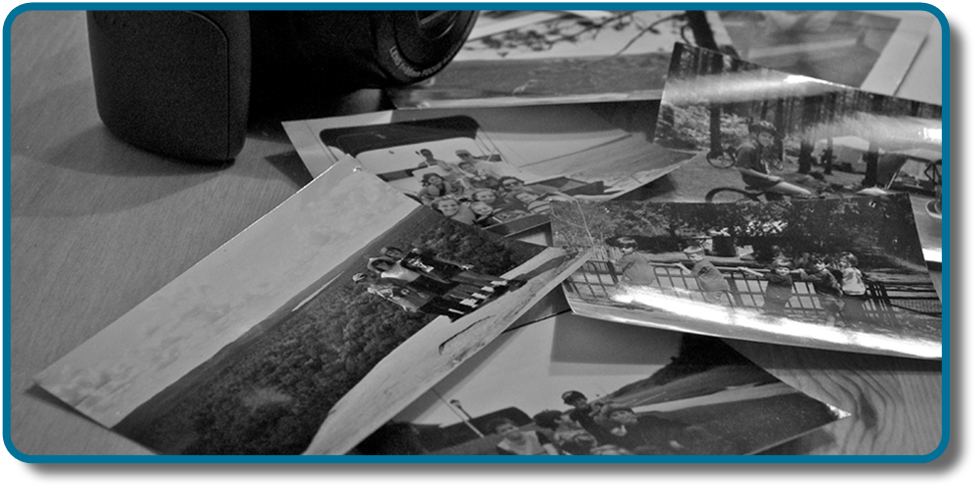8.1: Utangulizi wa Kumbukumbu
- Page ID
- 177447
Malengo ya kujifunza
- Tunashughulikiaje na kuhifadhi habari

Tunaweza kuwa wanafunzi wa juu-notch, lakini kama hatuna njia ya kuhifadhi kile tumejifunza, ni nzuri gani maarifa tuliyopata?
Chukua dakika chache kufikiria nini siku yako inaweza kuwa kama huwezi kukumbuka chochote ulichojifunza. Ungepaswa kujua jinsi ya kuvaa. Je! Unapaswa kuvaa nguo gani, na vifungo na zippers hufanya kazi? Ungependa mtu kukufundisha jinsi ya kupiga meno yako na kufunga viatu vyako. Ni nani ungeomba msaada katika kazi hizi, kwani hutambui nyuso za watu hawa nyumbani kwako? Kusubiri. Je! Hii ni nyumba yako? Uh oh, tumbo lako huanza rumble na kujisikia njaa. Ungependa kitu cha kula, lakini hujui ambapo chakula kinahifadhiwa au hata jinsi ya kuitayarisha. Oh mpendwa, hii ni kupata utata. Labda itakuwa bora tu kurudi kitandani. Kitanda.. kitanda ni nini?
Tuna uwezo wa ajabu wa kumbukumbu, lakini jinsi gani, hasa, tunachunguza na kuhifadhi habari? Je, kuna aina tofauti za kumbukumbu, na ikiwa ndivyo, ni nini kinachofafanua aina tofauti? Jinsi gani, hasa, tunapata kumbukumbu zetu? Na kwa nini sisi kusahau? Sura hii itachunguza maswali haya tunapojifunza kuhusu kumbukumbu.
References
Abel, M., & Bäuml, K.-H. T. (2013). Sleep can reduce proactive interference. Memory, 22(4), 332–339. doi:10.1080/09658211.2013.785570.
Anderson, N. S. (1969). The influence of acoustic similarity on serial recall of letter sequences. Quarterly Journal of Experimental Psychology, 21(3), 248–255.
Anderson, R. C. (1984). Role of the reader's schema in comprehension, learning, and memory. In R. C. Anderson, J. Osborn, & R. J. Tierney (Eds.), Learning to read in American schools: Basal Readers and Content Texts (pp. 243–257). Hillsdale, NJ: Erlbaum.
Atkinson, R. C., & Shiffrin, R. M. (1968). Human memory: A proposed system and its control processes. In K. W. Spence & J. T. Spence (Eds.), The psychology of learning and motivation: Volume 2 (pp. 89–195). New York, NY: Academic Press.
Baddeley, A. (2004). Your memory: A user's guide. Richmond Hill, Canada: Firefly Books.
Baddeley, A. D., & Hitch, G. (1974). Working memory. In G. H. Bower (Ed.), The psychology of learning and motivation: Advances in research and theory (Vol. 8, pp. 47–89). New York, NY: Academic Press.
Bayley, P. J., & Squire, L. R. (2002). Medial temporal lobe amnesia: Gradual acquisition of factual information by nondeclarative memory. Journal of Neuroscience, 22, 5741–5748.
Bellezza, F. S. (1981). Mnemonic devices: Classification, characteristics and criteria. Review of Educational Research, 51, 247–275.
Benjamin N. Cardozo School of Law, Yeshiva University. (2009). Reevaluating lineups: Why witnesses make mistakes and how to reduce the chance of a misidentification.
Blockland, A. (1996). Acetylcholine: A neurotransmitter for learning and memory? Brain Research Reviews, 21, 285–300.
Bodie, G. D., Powers, W. G., & Fitch-Hauser, M. (2006). Chunking, priming, and active learning: Toward an innovative approach to teaching communication-related skills. Interactive Learning Environment, 14(2), 119–135.
Bousfield, W. (1935). The occurrence of clustering in the recall of randomly arranged associates. Journal of General Psychology, 49, 229–240.
Bransford, J. D., & McCarrell, N. S. (1974). A sketch of a cognitive approach to comprehension. In W. B. Weimer & D. J. Palermo (Eds.), Cognition and the symbolic processes (pp. 189–229). Hillsdale, NJ: Lawrence Erlbaum Associates.
Briere, J., & Conte, J. (1993). Self-reported amnesia for abuse in adults molested as children. Journal of Traumatic Stress, 6, 21–31.
Carli, L. (1999). Cognitive reconstruction, hindsight, and reactions to victims and perpetrators. Personality and Social Psychology Bulletin, 25(8), 966–979. doi:10.1177/01461672992511005
Ceci, S. J., & Bruck, M. (1993). Child witness: Translating research into policy. Social Policy Report, 7(3), 1–30.
Ceci, S. J., & Bruck, M. (1995). Jeopardy in the courtroom: A scientific analysis of children’s testimony. Washington, DC: American Psychological Association.
Cheit, R. E. (2007). The recovered memory project. Retrieved from http://blogs.brown.edu/recoveredmemory/.
Christianson, S. A. (1992). The handbook of emotion and memory: Research and theory. Hillsdale, NJ: Erlbaum.
Clark, R. E., Zola, S. M., & Squire, L. R. (2000). Impaired recognition memory in rats after damage to the hippocampus. The Journal of Neuroscience, 20(23), 8853–8860.
Corkin, S. (1965). Tactually-guided maze learning in man: Effects of unilateral cortical excisions and bilateral hippocampal lesions. Neuropsychologia, 3, 339–351.
Corkin, S. (1968). Acquisition of motor skill after bilateral medial temporal-lobe excision. Neuropsychologia, 6, 255–264.
Corkin, S., Amaral D. G., González, R. G., Johnson, K. A., & Hyman, B. T. (1997). H. M.’s medial temporal lobe lesion: Findings from magnetic resonance imaging. Journal of Neuroscience, 17(10), 3964–3979.
Craik, F. I. M., & Lockhart, R. S. (1972). Levels of processing: A framework for memory research. Journal of Verbal Learning and Verbal Behavior, 11, 671–684.
Craik, F. I. M., Moroz, T. M., Moscovitch, M., Stuss, D. T., Winocur, G., Tulving, E., & Kapur, S. (1999). In search of the self: A positron emission tomography study. Psychological Science, 10(1), 26–34.
Craik, F. I. M., & Tulving, E. (1975). Depth of processing and the retention of words in episodic memory. Journal of Experimental Psychology, 104(3), 268–294.
Craik, F. I. M., & Watkins, M. J. (1973). The role of rehearsal in short-term memory. Journal of Verbal Learning and Verbal Behavior, 12, 599–607.
Green, J. T., & Woodruff-Pak, D. S. (2000). Eyeblink classical conditioning in aging animals. In D. S. Woodruff-Pak & J. E. Steinmetz (Eds.), Eyeblink classical conditioning: Animal models (Vol. 2, pp.155–178). Boston, MA: Kluwer Academic.
Greenberg, D. L. (2004). President Bush's false [flashbulb] memory of 9/11/01. Applied. Cognitive Psychology, 18(3), 363–370. doi:10.1002/acp.1016
Devilly, G. J. (2007). If nothing happened why do I still hurt? An update on the memory wars. InPsych, 29(2), 16–18.
Ebbinghaus, H. (1964). Memory: A contribution to experimental psychology (H. A. Ruger & C. E. Bussenius, Trans.). New York, NY: Dover. (Original work published 1885)
Goodman, G. S. (2006). Children’s eyewitness memory: A modern history and contemporary commentary. Journal of Social Issues, 62, 811–832.
Hassabis D., & Maguire E. A. (2007). Deconstructing episodic memory with construction. Trends in Cognitive Sciences, 11(7), 299–306.
Jacobs, J. (1887). Experiments on “prehension.” Mind, 12, 75–79.
Josselyn, J. A. (2010). Continuing the search for the engram: Examining the mechanism of fear memories. Journal of Psychiatry Neuroscience, 35(4), 221–228.
Kapur, S., Craik, F. I. M., Tulving, E., Wilson, A. A., Houle, S., & Brown, G. M. (1994). Neuroanatomical correlates of encoding in episodic memory: Levels of processing effect. Proceedings of the National Academy of Sciences of the United States of America, 91(6), 208–2011.
Lashley K. S. (1950). In search of the engram. Society of Experimental Biology Symposium, 4: Psychological Mechanisms in Animal Behavior. Cambridge, UK: Cambridge University Press.
Loftus, E. F., & Palmer, J. C. (1974). Reconstruction of auto-mobile destruction: An example of the interaction between language and memory. Journal of Verbal Learning and Verbal Behavior, 13, 585–589.
MacLeod, C. M., Gopie, N., Hourihan, K. L., Neary, K. R., & Ozubko, J. D. (2010). The production effect: Delineation of a phenomenon. Journal of Experimental Psychology: Learning, Memory, and Cognition, 36(3), 671–685.
Mayford, M., Siegelbaum, S. A., & Kandel, E. R. (2012). Synapses and memory storage. New York, NY: Cold Spring Harbor Perspectives in Biology, Cold Spring Harbor Laboratory Press.
McGaugh, J. L. (2003). Memory and emotion: The making of lasting memories. New York, NY: Columbia University Press.
McLeod, S. A. (2011). Anterograde amnesia [Web log post]. Retrieved from www.simplypsychology.org/ante...e-amnesia.html
Miller, G. A. (1956). The magical number seven, plus or minus two: Some limits on our capacity for processing information. Psychological Review, 68, 81–87.
Myhrer, T. (2003). Neurotransmitter systems involved in learning and memory in the rat: A meta-analysis based on studies of four behavioral tasks. Brain Research Reviews, 41(2–3), 268–287.
Newseum. (n.d.). G-men and journalists: D. C. sniper [Web log post].
Nickerson, R. S., & Adams, M. J. (1979). Long-term memory for a common object. Cognitive Psychology, 11(3), 287–307.
Paivio, A. (1986). Mental representations: A dual coding approach. New York, NY: Oxford University Press.
Parker, E. S., Cahill, L., & McGaugh, J. L. (2006). A case of unusual autobiographical remembering. Neurocase, 12, 35–49.
Payne, B. K., Jacoby, L. L., & Lambert, A. J. (2004). Memory monitoring and the control of stereotype distortion. Journal of Experimental Social Psychology, 40, 52–64.
Pew Research Center (2011, September 1). Ten years after 9/11: United in remembrance, divided over policies. Washington, DC: People Press.
Pipe, M.-E. (1996). Children’s eyewitness memory. New Zealand Journal of Psychology, 25(2), 36–43.
Pipe, M.-E., Lamb, M., Orbach, Y., & Esplin, P. W. (2004). Recent research on children’s testimony about experienced and witnessed events. Developmental Review, 24, 440–468.
Roediger, H. L., & DeSoto, K. A. (in press). The psychology of reconstructive memory. In J. Wright (Ed.), International Encyclopedia of the Social and Behavioral sciences, 2e. Oxford, UK: Elsevier.
Roediger, H. L., III, & McDermott, K. B. (2000). Tricks of memory. Current Directions in Psychological Science, 9, 123–127.
Rogers, T. B., Kuiper, N. A., & Kirker, W. S. (1977). Self-reference and the encoding of personal information. Journal of Personal Social Psychology, 35(9), 677–688.
Schacter, D. (2001). The seven sins of memory: How the mind forgets and remembers. New York, NY: Houghton Mifflin.
Steinmetz, J. E. (1999). A renewed interest in human classical eyeblink conditioning. Psychological Science, 10, 24–25.
Tigner, R. B. (1999). Putting memory research to good use. College Teaching, 47(4), 149–152.
Tulving, E. (1972). Episodic and semantic memory. In E. Tulving & W. Dolandson (Eds.), Organization of memory (pp. 381–403). New York, NY: Academic Press.
Tulving, E. (2002, February). Episodic memory: From mind to brain. Annual Review of Psychology, 53, 1–25. doi:10.1146/annurev.psych.53.100901.135114
van Praag, H. (2008). Neurogenesis and exercise: Past and future directions. NeuroMolecular Medicine, 10(2), 128–140.
Wells, G. L., & Quinlivan, D. S. (2009). Suggestive eyewitness identification procedures and the Supreme Court’s reliability test in light of eyewitness science: 30 years later. Law and Human Behavior, 33, 1–24. doi:10.1007/s10979-008-9130-3
Wrubel, B. (Writer), & Spiller, M. (Director). (2010). The Old Wagon [Television series episode]. In S. Levitan & C. Lloyd (Executive producers), Modern Family. 20th Century Fox Television.
Yogo, M., & Fujihara, S. (2008). Working memory capacity can be improved by expressive writing: A randomized experiment in a Japanese sample. British Journal of Health Psychology, 13(1), 77–80. doi:10.1348/135910707X252440


